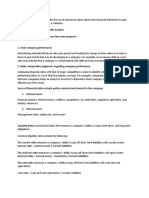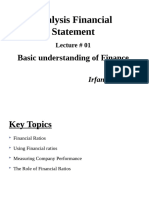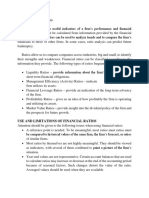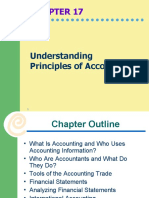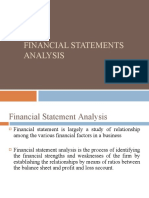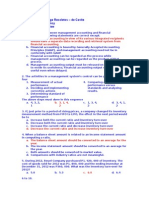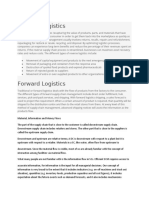"How Well Am I Doing?" Financial Statement Analysis: Mcgraw-Hill/Irwin
"How Well Am I Doing?" Financial Statement Analysis: Mcgraw-Hill/Irwin
Uploaded by
rayjoshua12Copyright:
Available Formats
"How Well Am I Doing?" Financial Statement Analysis: Mcgraw-Hill/Irwin
"How Well Am I Doing?" Financial Statement Analysis: Mcgraw-Hill/Irwin
Uploaded by
rayjoshua12Original Title
Copyright
Available Formats
Share this document
Did you find this document useful?
Is this content inappropriate?
Copyright:
Available Formats
"How Well Am I Doing?" Financial Statement Analysis: Mcgraw-Hill/Irwin
"How Well Am I Doing?" Financial Statement Analysis: Mcgraw-Hill/Irwin
Uploaded by
rayjoshua12Copyright:
Available Formats
How Well Am I Doing?
Financial
Statement Analysis
Chapter 16
McGraw-Hill/Irwin
Copyright 2010 by The McGraw-Hill Companies, Inc. All rights reserved.
Limitations of Financial Statement Analysis
Differences in accounting methods
between companies sometimes make
comparisons difficult.
We use the LIFO method to
value inventory.
We use the average cost
method to value inventory.
16-2
Limitations of Financial Statement Analysis
Analysts should look beyond the ratios.
Economic
factors
Industry
trends
Changes within
the company
Technological
changes
Consumer
tastes
16-3
Statements in Comparative and Common-
Size Form
Dollar and percentage
changes on statements
Common-size
statements
Ratios
An item on a financial
statement has little
meaning by itself. The
meaning of the numbers
can be enhanced by
drawing comparisons.
16-4
Horizontal Analysis
Calculating Change in Dollar Amounts
Dollar
Change
Current Year
Figure
Base Year
Figure
=
The dollar
amounts for
2007 become
the base year
figures.
16-5
Calculating Change as a Percentage
Percentage
Change
Dollar Change
Base Year Figure
100% =
Horizontal Analysis
16-6
Trend Percentages
Trend percentages
state several years
financial data in terms
of a base year, which
equals 100 percent.
16-7
Trend Analysis
Trend
Percentage
Current Year Amount
Base Year Amount
100% =
16-8
Common-Size Statements
Vertical analysis focuses
on the relationships
among financial
statement items at a
given point in time. A
common-size financial
statement is a vertical
analysis in which each
financial statement item
is expressed as a
percentage.
16-9
Common-Size Statements
In income
statements, all
items usually
are expressed
as a percentage
of sales.
16-10
Gross Margin Percentage
Gross Margin
Percentage
Gross Margin
Sales
=
This measure indicates how much
of each sales dollar is left after
deducting the cost of goods sold to
cover expenses and provide a profit.
16-11
Common-Size Statements
In balance
sheets, all items
usually are
expressed as a
percentage of
total assets.
16-12
Common-Size Statements
Wendy's McDonald's
(dollars in millions) Dollars Percentage Dollars Percentage
2007 Net income 88 $ 3.60% 2,396 $ 10.50%
Common-size financial statements are
particularly useful when comparing
data from different companies.
16-13
Ratio Analysis The Common Stockholder
The ratios that
are of the most
interest to
stockholders
include those
ratios that focus
on net income,
dividends, and
stockholders
equities.
NORTON CORPORATION
2008
Number of common shares
outstanding
Beginning of year 17,000
End of year 27,400
Net income 53,690 $
Stockholders' equity
Beginning of year 180,000
End of year 234,390
Dividends per share 2
Dec. 31 market price per share 20
Interest expense 7,300
Total assets
Beginning of year 300,000
End of year 346,390
16-14
Earnings Per Share
Earnings per Share
Net Income Preferred Dividends
Average Number of Common
Shares Outstanding
=
Whenever a ratio divides an income statement
balance by a balance sheet balance, the average
for the year is used in the denominator.
Earnings form the basis for dividend payments
and future increases in the value of shares of
stock.
16-15
Earnings Per Share
Earnings per Share
Net Income Preferred Dividends
Average Number of Common
Shares Outstanding
=
Earnings per Share
$53,690 $0
($17,000 + $27,400)/2
= = $2.42
This measure indicates how much
income was earned for each share of
common stock outstanding.
16-16
Price-Earnings Ratio
Price-Earnings
Ratio
Market Price Per Share
Earnings Per Share
=
Price-Earnings
Ratio
$20.00
$2.42
= = 8.26 times
A higher price-earnings ratio means that
investors are willing to pay a premium
for a companys stock because of
optimistic future growth prospects.
16-17
Dividend Payout Ratio
Dividend
Payout Ratio
Dividends Per Share
Earnings Per Share
=
Dividend
Payout Ratio
$2.00
$2.42
= = 82.6%
This ratio gauges the portion of current
earnings being paid out in dividends. Investors
seeking dividends (market price growth) would
like this ratio to be large (small).
16-18
Dividend Yield Ratio
Dividend
Yield Ratio
Dividends Per Share
Market Price Per Share
=
Dividend
Yield Ratio
$2.00
$20.00
= = 10.00%
This ratio identifies the return, in terms
of cash dividends, on the current
market price of the stock.
16-19
Return on Total Assets
Adding interest expense back to net income
enables the return on assets to be compared
for companies with different amounts of debt
or over time for a single company that has
changed its mix of debt and equity.
Return on
Total Assets
$53,690 + [$7,300 (1 .30)]
($300,000 + $346,390) 2
= = 18.19%
Return on
Total Assets
Net Income + [Interest Expense (1 Tax Rate)]
Average Total Assets
=
16-20
Return on Common Stockholders Equity
Return on Common
Stockholders Equity
Net Income Preferred Dividends
Average Stockholders Equity
=
Return on Common
Stockholders Equity
$53,690 $0
($180,000 + $234,390) 2
= = 25.91%
This measure indicates how well the
company used the owners
investments to earn income.
16-21
Financial Leverage
Financial leverage results from the difference
between the rate of return the company earns on
investments in its own assets and the rate of return
that the company must pay its creditors.
Return on
investment in
assets
>
Fixed rate of
return on
borrowed
funds
Positive
financial
leverage
=
Return on
investment in
assets
<
Fixed rate of
return on
borrowed
funds
Negative
financial
leverage
=
16-22
Book Value Per Share
Book Value
per Share
Common Stockholders Equity
Number of Common Shares Outstanding
=
This ratio measures the amount that would be
distributed to holders of each share of common
stock if all assets were sold at their balance sheet
carrying amounts after all creditors were paid off.
= $ 8.55
Book Value
per Share
$234,390
27,400
=
16-23
Book Value Per Share
Notice that the book value per share of $8.55 does
not equal the market value per share of $20. This
is because the market price reflects expectations
about future earnings and dividends, whereas the
book value per share is based on historical cost.
Book Value
per Share
Common Stockholders Equity
Number of Common Shares Outstanding
=
= $ 8.55
Book Value
per Share
$234,390
27,400
=
16-24
Ratio Analysis The ShortTerm Creditor
Short-term
creditors, such as
suppliers, want to
be paid on time.
Therefore, they
focus on the
companys cash
flows and working
capital.
NORTON CORPORATION
2008
Cash 30,000 $
Accounts receivable, net
Beginning of year 17,000
End of year 20,000
Inventory
Beginning of year 10,000
End of year 12,000
Total current assets 65,000
Total current liabilities 42,000
Sales on account 494,000
Cost of goods sold 140,000
16-25
Working Capital
The excess of current assets over
current liabilities is known as
working capital.
Working capital is not
free. It must be
financed with long-
term debt and equity.
16-26
Working Capital
December 31,
2008
Current assets 65,000 $
Current liabilities (42,000)
Working capital 23,000 $
16-27
Current Ratio
The current ratio measures a
companys short-term debt paying
ability.
A declining ratio may be a
sign of deteriorating
financial condition, or it
might result from eliminating
obsolete inventories.
Current
Ratio
Current Assets
Current Liabilities
=
16-28
Current Ratio
Current
Ratio
$65,000
$42,000
= = 1.55
Current
Ratio
Current Assets
Current Liabilities
=
16-29
Acid-Test (Quick) Ratio
Quick Assets
Current Liabilities
=
Acid-Test
Ratio
Quick assets include Cash,
Marketable Securities, Accounts Receivable, and
current Notes Receivable.
This ratio measures a companys ability to meet
obligations without having to liquidate inventory.
$50,000
$42,000
= 1.19 =
Acid-Test
Ratio
16-30
Accounts Receivable Turnover
Sales on Account
Average Accounts Receivable
Accounts
Receivable
Turnover
=
This ratio measures how many
times a company converts its
receivables into cash each year.
= 26.7 times
$494,000
($17,000 + $20,000) 2
Accounts
Receivable
Turnover
=
16-31
Average Collection Period
Average
Collection
Period
=
365 Days
Accounts Receivable Turnover
This ratio measures, on average,
how many days it takes to collect
an account receivable.
= 13.67 days
Average
Collection
Period
=
365 Days
26.7 Times
16-32
Inventory Turnover
This ratio measures how many times a
companys inventory has been sold and
replaced during the year.
If a companys inventory
turnover Is less than its
industry average, it either
has excessive inventory or
the wrong types of inventory.
Cost of Goods Sold
Average Inventory
Inventory
Turnover
=
16-33
Inventory Turnover
Cost of Goods Sold
Average Inventory
Inventory
Turnover
=
= 12.73 times
$140,000
($10,000 + $12,000) 2
Inventory
Turnover
=
16-34
Average Sale Period
Average
Sale Period
=
365 Days
Inventory Turnover
This ratio measures how many
days, on average, it takes to sell
the entire inventory.
= 28.67 days
Average
Sale Period
=
365 Days
12.73 Times
16-35
Ratio Analysis The LongTerm Creditor
Long-term creditors are concerned with a
companys ability to repay its loans over the
long-run.
NORTON CORPORATION
2008
Earnings before interest
expense and income taxes 84,000 $
Interest expense 7,300
Total stockholders' equity 234,390
Total liabilities 112,000
This is also referred
to as net operating
income.
16-36
Times Interest Earned Ratio
This is the most common
measure of a companys ability
to provide protection for its long-
term creditors. A ratio of less
than 1.0 is inadequate.
Times
Interest
Earned
Earnings before Interest Expense
and Income Taxes
Interest Expense
=
Times
Interest
Earned
$84,000
$7,300
= = 11.51 times
16-37
Debt-to-Equity Ratio
This ratio indicates the relative proportions
of debt to equity on a companys balance
sheet.
Stockholders like a lot of
debt if the company can
take advantage of positive
financial leverage.
Creditors prefer less debt
and more equity because
equity represents a buffer
of protection.
Total Liabilities
Stockholders Equity
Debtto
Equity
Ratio
=
16-38
Debt-to-Equity Ratio
$112,000
$234,390
Debtto
Equity
Ratio
= = 0.48
Total Liabilities
Stockholders Equity
Debtto
Equity
Ratio
=
16-39
Published Sources That Provide
Comparative Ratio Data
16-40
End of Chapter 16
16-41
You might also like
- Alrajhi-0 24197511330724852Document1 pageAlrajhi-0 24197511330724852Shafie Zubier100% (1)
- A Level Economics NotesDocument41 pagesA Level Economics NotesNgọc Phạm MinhNo ratings yet
- Chapter01.the Changing Role of Managerial Accounting in A Dynamic Business EnvironmentDocument13 pagesChapter01.the Changing Role of Managerial Accounting in A Dynamic Business EnvironmentEleia Cruz 吳玉青100% (2)
- Li Lu's 2010 Lecture at Columbia My Previous Transcript View A More Recent LectureDocument14 pagesLi Lu's 2010 Lecture at Columbia My Previous Transcript View A More Recent Lecturepa_langstrom100% (1)
- Nalysis OF Inancial TatementsDocument43 pagesNalysis OF Inancial TatementsBoo LeNo ratings yet
- Chapter Four - Financial AnalysisDocument27 pagesChapter Four - Financial AnalysisbavanthinilNo ratings yet
- Jamil Ahmed Assistant ProfessorDocument29 pagesJamil Ahmed Assistant ProfessorParizad456No ratings yet
- 16 How Well Am I Doing Financial Statement Analysis Compatibility ModeDocument41 pages16 How Well Am I Doing Financial Statement Analysis Compatibility ModeVinluan Jerome100% (1)
- RatiosDocument2 pagesRatiospvbatheNo ratings yet
- Creating A Successful Financial PlanDocument29 pagesCreating A Successful Financial PlanNaveed Mughal AcmaNo ratings yet
- Chapter Five - Financial RatiosDocument33 pagesChapter Five - Financial RatiosbavanthinilNo ratings yet
- Financial RatiosDocument7 pagesFinancial RatiosJessaNo ratings yet
- FIN 571 Connect Problem Final Exam Answers - UOP E AssignmentsDocument14 pagesFIN 571 Connect Problem Final Exam Answers - UOP E AssignmentsuopeassignmentsNo ratings yet
- ACF 361 4 To 6Document157 pagesACF 361 4 To 6edithyemehNo ratings yet
- Analysis Financial Statement: Basic Understanding of FinanceDocument73 pagesAnalysis Financial Statement: Basic Understanding of Financeahkkhan349No ratings yet
- Lecture 15 NotesDocument60 pagesLecture 15 Noteskk23212No ratings yet
- Financial Statement Analysis Word FileDocument25 pagesFinancial Statement Analysis Word FileolmezestNo ratings yet
- Analysis of Financial Statements: BY Rana Asghar AliDocument31 pagesAnalysis of Financial Statements: BY Rana Asghar AliMaxhar AbbaxNo ratings yet
- What Are Financial Ratios?: Uses and Users of Financial Ratio AnalysisDocument5 pagesWhat Are Financial Ratios?: Uses and Users of Financial Ratio AnalysisGultayaz khanNo ratings yet
- CH 5 - Fin RatiosDocument18 pagesCH 5 - Fin RatiosbavanthinilNo ratings yet
- Financial Ratio AnalysisDocument47 pagesFinancial Ratio AnalysisArsalan Ali KhowajaNo ratings yet
- Ratio AnaDocument13 pagesRatio Anakennetjoel8No ratings yet
- Financial Ratios - ReadingsDocument5 pagesFinancial Ratios - Readingsdeborah remigioNo ratings yet
- Financial Statement Analysis Part 2 (Lomenario, Anna Marie, S.)Document27 pagesFinancial Statement Analysis Part 2 (Lomenario, Anna Marie, S.)Anna LomenarioNo ratings yet
- What Are Financial Ratios?Document3 pagesWhat Are Financial Ratios?Ryzza Yvonne MedalleNo ratings yet
- Financial Ratio AnalysisDocument42 pagesFinancial Ratio Analysisfattiq_1No ratings yet
- UGBA 102A Chapter 13 Without SolutionsDocument51 pagesUGBA 102A Chapter 13 Without SolutionsJasmin TranNo ratings yet
- Key Financial RatiosDocument4 pagesKey Financial RatiosTien TranNo ratings yet
- The CommonDocument5 pagesThe CommonDarshan SawantNo ratings yet
- Financial Statement AnalysisDocument3 pagesFinancial Statement AnalysisLEIN JSNo ratings yet
- Lesson 2A - Financial RatiosDocument4 pagesLesson 2A - Financial RatiosButchoy ButchukoyNo ratings yet
- Ratio Analysis: Ratio Analysis Is The Process of Establishing and Interpreting Various RatiosDocument26 pagesRatio Analysis: Ratio Analysis Is The Process of Establishing and Interpreting Various RatiosTarpan Mannan100% (2)
- Chapter 2 Review of FSDocument37 pagesChapter 2 Review of FSAiron Bendaña100% (1)
- CH 06 FinancialStatementAnalysisDocument56 pagesCH 06 FinancialStatementAnalysisMeghashyam AddepalliNo ratings yet
- Financial Ratios Are Grouped Into The Following CategoriesDocument6 pagesFinancial Ratios Are Grouped Into The Following CategoriesReginald ValenciaNo ratings yet
- 2101 Lecture 11Document46 pages2101 Lecture 11alexgallegoNo ratings yet
- FIN 571 Final Exam: FIN 571 Final Exam Ansers For Uop - UOP E Tutorsinal ExamDocument17 pagesFIN 571 Final Exam: FIN 571 Final Exam Ansers For Uop - UOP E Tutorsinal ExamUOP E TutorsNo ratings yet
- What Are Financial RatiosDocument6 pagesWhat Are Financial Ratiosmichelle dizon100% (1)
- Uses and Users of Financial Ratio AnalysisDocument6 pagesUses and Users of Financial Ratio AnalysisOMKAR PADAVENo ratings yet
- Unit 2 RatioDocument51 pagesUnit 2 Ratiov9510491No ratings yet
- CH 06 FinancialStatementAnalysisDocument56 pagesCH 06 FinancialStatementAnalysisSalman AhmedNo ratings yet
- HOD Assignment 2Document15 pagesHOD Assignment 2KUMARAGURU PONRAJNo ratings yet
- Financial Statement Analysis: Mcgraw-Hill/IrwinDocument42 pagesFinancial Statement Analysis: Mcgraw-Hill/IrwinDiana Fernandez MagnoNo ratings yet
- Fatema NusratDocument10 pagesFatema NusratFatema NusratNo ratings yet
- Ratio Analysis (Buet)Document13 pagesRatio Analysis (Buet)Tahsinul Haque TasifNo ratings yet
- Financial Ratios Are Useful Indicators of A Firm's Performance and FinancialDocument5 pagesFinancial Ratios Are Useful Indicators of A Firm's Performance and FinancialSef Getizo CadoNo ratings yet
- AccountDocument16 pagesAccountMohamad AlifNo ratings yet
- Financial RatiosDocument5 pagesFinancial Ratiosarrowphoto8161343rejelynNo ratings yet
- What Is Corporate Finance? Corporate Finance Is The Field of Finance Dealing With Financial Decisions BusinessDocument26 pagesWhat Is Corporate Finance? Corporate Finance Is The Field of Finance Dealing With Financial Decisions BusinessAkhilesh PanwarNo ratings yet
- Financial Statement Analysis Chapter 13Document65 pagesFinancial Statement Analysis Chapter 13Rupesh PolNo ratings yet
- Principles of AccountingDocument28 pagesPrinciples of Accountingyasir100% (1)
- Financial Statements: The Balance Sheet, Income Statement, and Cash Flow StatementDocument8 pagesFinancial Statements: The Balance Sheet, Income Statement, and Cash Flow Statementr.jeyashankar9550No ratings yet
- Nalysis ND Nterpretation F Inancial TatementsDocument31 pagesNalysis ND Nterpretation F Inancial TatementsKristjan Ley CalingasanNo ratings yet
- Financial Statement Analysis: Slide 15.1Document21 pagesFinancial Statement Analysis: Slide 15.1arshad mNo ratings yet
- Presented By-Group 11 Umashankar Joshi (131) Ruchi Gupta (132) Ravish Kapoor (133) Archana Madhu KumaraDocument45 pagesPresented By-Group 11 Umashankar Joshi (131) Ruchi Gupta (132) Ravish Kapoor (133) Archana Madhu KumaraRuchi GuptaNo ratings yet
- Ratio AnalysisDocument38 pagesRatio AnalysismdalakotiNo ratings yet
- @2015 FM I CH 2-IFRS Based Financilal AnlysisDocument50 pages@2015 FM I CH 2-IFRS Based Financilal Anlysismkmkd854No ratings yet
- Financial ManagementDocument22 pagesFinancial ManagementaghxdaddyNo ratings yet
- LectureDocument28 pagesLectureAashir AsadNo ratings yet
- Ratios & Interpretation 2022Document12 pagesRatios & Interpretation 2022Uma NNo ratings yet
- Financial Statement AnalysisDocument92 pagesFinancial Statement Analysisjohnsmith1806No ratings yet
- 04 Evaluating Operating and Financial Performance PDFDocument31 pages04 Evaluating Operating and Financial Performance PDFMiguel Gonzalez LondoñoNo ratings yet
- Business Metrics and Tools; Reference for Professionals and StudentsFrom EverandBusiness Metrics and Tools; Reference for Professionals and StudentsNo ratings yet
- Documentary Stamp Taxes: Business and Transfer Taxation 6Th Edition (By: Valencia & Roxas) Suggested AnswersDocument3 pagesDocumentary Stamp Taxes: Business and Transfer Taxation 6Th Edition (By: Valencia & Roxas) Suggested Answersrayjoshua12No ratings yet
- Business TaxesDocument23 pagesBusiness Taxesrayjoshua12No ratings yet
- Chapter 3 - Gross Estate2013Document8 pagesChapter 3 - Gross Estate2013rayjoshua12No ratings yet
- Quiz#1 MaDocument5 pagesQuiz#1 Marayjoshua12No ratings yet
- Customers Cashier: Entities paraDocument6 pagesCustomers Cashier: Entities pararayjoshua12No ratings yet
- ApplauseDocument16 pagesApplauserayjoshua12No ratings yet
- CH 19Document16 pagesCH 19rayjoshua12No ratings yet
- Capital Budgeting Decisions: Mcgraw-Hill/IrwinDocument38 pagesCapital Budgeting Decisions: Mcgraw-Hill/Irwinrayjoshua12No ratings yet
- Profitability Analysis: Appendix BDocument17 pagesProfitability Analysis: Appendix Brayjoshua12No ratings yet
- "How Well Am I Doing?" Statement of Cash Flows: Mcgraw-Hill/IrwinDocument23 pages"How Well Am I Doing?" Statement of Cash Flows: Mcgraw-Hill/Irwinrayjoshua12No ratings yet
- Inventory ManagementDocument3 pagesInventory Managementrayjoshua12No ratings yet
- Book Reviews of Robert Guest 2004 The Shackled Continent5Document3 pagesBook Reviews of Robert Guest 2004 The Shackled Continent5Girma KusaNo ratings yet
- AC23-0094 Ebook WhyInvest en-USDocument30 pagesAC23-0094 Ebook WhyInvest en-USReneeNo ratings yet
- Reverse LogisticsDocument2 pagesReverse LogisticsMeenakshi SinghNo ratings yet
- Four Principles Management Consulting1Document2 pagesFour Principles Management Consulting1Majid KhanNo ratings yet
- Taxation For Self-Employed Ver1.0Document23 pagesTaxation For Self-Employed Ver1.0Xeena HavenNo ratings yet
- Assignment On Investment OptionsDocument6 pagesAssignment On Investment OptionsHariom AgarwalNo ratings yet
- Finance: GMR Productions Limited Kemp House, 152 - 160 City Road, London EC1V 2NX Company Registration ID: 13388085Document10 pagesFinance: GMR Productions Limited Kemp House, 152 - 160 City Road, London EC1V 2NX Company Registration ID: 13388085Iuri PiragibeNo ratings yet
- Business Level Strategy SAMSUNG: Product Differentiation Strategies During Its LifetimeDocument5 pagesBusiness Level Strategy SAMSUNG: Product Differentiation Strategies During Its LifetimeSardor JuraevNo ratings yet
- The Chartered Insurance Institute Diploma April 2010 Examination PaperDocument8 pagesThe Chartered Insurance Institute Diploma April 2010 Examination PaperSultan AlrasheedNo ratings yet
- RRL and MethodologyDocument5 pagesRRL and MethodologyRandom ThingsNo ratings yet
- MEC 1st Year 2020-21 EnglishDocument16 pagesMEC 1st Year 2020-21 EnglishKumar UditNo ratings yet
- Malaysia - Import Procedure Guide EN 20161219Document40 pagesMalaysia - Import Procedure Guide EN 20161219Hawa AzizNo ratings yet
- 3$how Monetary Policy Affects The Forex Market - BaDocument1 page3$how Monetary Policy Affects The Forex Market - BaDickson MakoriNo ratings yet
- Municipal Assessor's Office Citizen's CharterDocument8 pagesMunicipal Assessor's Office Citizen's CharterJoemar CaprancaNo ratings yet
- Multiple Choice: Select The Best Answer From The Given Choices and Write It Down On Your Answer SheetDocument14 pagesMultiple Choice: Select The Best Answer From The Given Choices and Write It Down On Your Answer Sheetmimi supasNo ratings yet
- Chapter 9 - Managing The Global PipelineDocument12 pagesChapter 9 - Managing The Global Pipelinesyazwani aliahNo ratings yet
- Expansion Plan For Ikea Into Chile Angli PDFDocument26 pagesExpansion Plan For Ikea Into Chile Angli PDFAntonio Baros MatteraNo ratings yet
- British American TobaccoDocument30 pagesBritish American TobaccoFahim YusufNo ratings yet
- Brokerage Statement - XXXX6691 - 202112Document6 pagesBrokerage Statement - XXXX6691 - 202112mikeNo ratings yet
- Covid-19Covid-19 - Impact On Agriculture & Allied Sectors in Odisha - Dealing With The PandemicDocument18 pagesCovid-19Covid-19 - Impact On Agriculture & Allied Sectors in Odisha - Dealing With The Pandemickiran viratNo ratings yet
- Key Leadership CompetenciesDocument3 pagesKey Leadership CompetenciesSuresh SivadasanNo ratings yet
- Rate NPV 351,212,178.13 365,660,986.27 290,844,716.89 207,520,203.54 Irr 180% 128% 189% 329%Document1 pageRate NPV 351,212,178.13 365,660,986.27 290,844,716.89 207,520,203.54 Irr 180% 128% 189% 329%pinkieNo ratings yet
- Bidgoli10e ch11Document42 pagesBidgoli10e ch11toysdreatNo ratings yet
- Answers Key Chapter 3 Deductions From Gross EstateDocument3 pagesAnswers Key Chapter 3 Deductions From Gross EstateNatepretty100% (1)
- Aeon VietnamDocument435 pagesAeon VietnamDataGroup Retailer AnalysisNo ratings yet
- LL IncDocument2 pagesLL IncLeiNo ratings yet
- Lean Manufacturing in Process IndustriesDocument23 pagesLean Manufacturing in Process IndustriesdrustagiNo ratings yet











